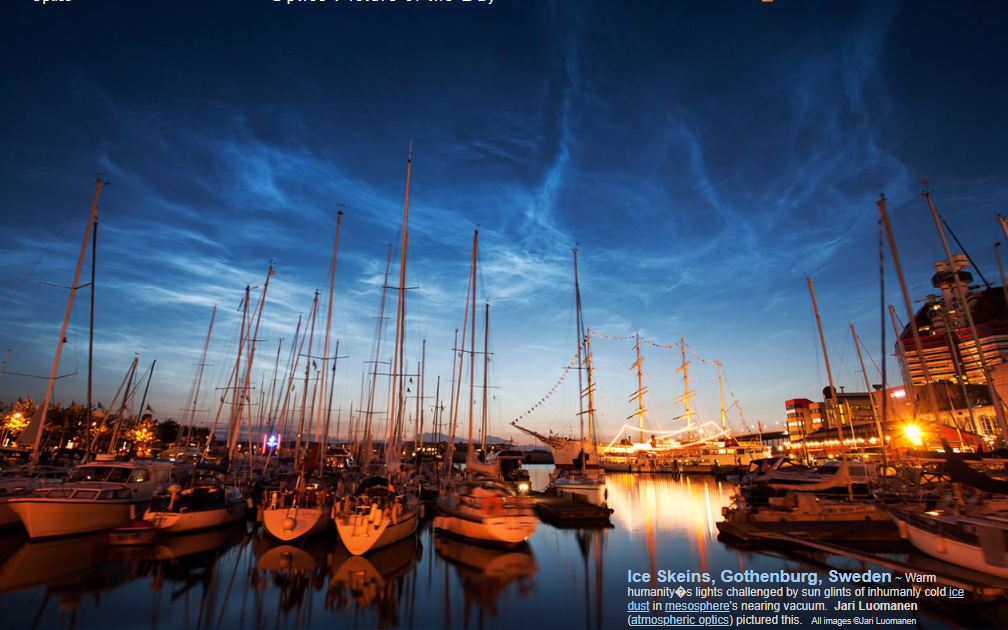Ice Skeins, NLCs, Gothenburg, Sweden - OPOD
Ice Skeins, NLCs, Gothenburg, Sweden - OPOD: A Mesospheric Spectacle
The city of Gothenburg in Sweden recently witnessed a mesmerizing display of atmospheric optics known as "Ice Skeins." These ethereal phenomena captivated the hearts of onlookers as warm lights of humanity clashed with the glints of inhumanly cold ice dust in the mesosphere's nearing vacuum. Renowned atmospheric optics photographer, Jari Luomanen, beautifully captured these stunning moments that juxtaposed the desolation of the cold against the warmth of human presence.
Ice Skeins are a type of noctilucent cloud (NLC), also referred to as polar mesospheric clouds. NLCs are unique cloud formations that occur at high altitudes in the Earth's mesosphere during summer months in polar regions. They are composed of tiny ice crystals and dust particles, giving them a wispy appearance. While these clouds are invisible during daylight, they become illuminated by sunlight when the lower layers of the atmosphere are in shadow.
The mesmerizing Ice Skeins observed in Gothenburg showcased the delicate dance between light and darkness. As the sun dipped below the horizon, these elusive clouds emerged, revealing their intricate structure. Jari Luomanen's photographs captured the interplay of warm city lights and the frigid beauty of the NLCs, creating a breathtaking visual spectacle.
The occurrence of Ice Skeins in Gothenburg is not a common sight. Typically, NLCs are observed closer to the polar regions due to specific atmospheric conditions. However, occasionally, these ethereal clouds extend further south, allowing for sightings in more southern locations such as Gothenburg. The rarity of such events only adds to their allure and makes them a subject of fascination for both scientists and enthusiasts alike.
Understanding the formation of NLCs and Ice Skeins requires an understanding of the mesosphere. The mesosphere is the third layer of the Earth's atmosphere, located above the stratosphere and below the thermosphere. It is a region of extreme cold, with temperatures dropping as low as -130 degrees Celsius (-202 degrees Fahrenheit). In this frigid environment, ice crystals and dust particles can form, creating the delicate structures that characterize NLCs.
The exact mechanisms behind the formation of NLCs are still not fully understood. However, it is believed that their formation involves a combination of factors, including the presence of water vapor, low temperatures, and the presence of dust particles. When these conditions align, ice crystals begin to form around the dust particles, eventually growing into the intricate structures that give NLCs their mesmerizing appearance.
Observing Ice Skeins in Gothenburg provides scientists with a unique opportunity to study these rare atmospheric phenomena. By analyzing photographs and data collected during these events, researchers can gain insights into the dynamics of the mesosphere and the processes that lead to the formation of NLCs. This knowledge is crucial for understanding the complex interactions between different layers of the atmosphere and for furthering our understanding of Earth's climate system.
In conclusion, the occurrence of Ice Skeins in Gothenburg, Sweden, showcased the beauty and mystique of polar mesospheric clouds. Jari Luomanen's photographs captured the delicate dance between warm city lights and the ethereal glints of ice dust in the mesosphere's frigid vacuum. These rare atmospheric phenomena provide scientists with valuable insights into the dynamics of the mesosphere and contribute to our understanding of Earth's climate system. As we continue to unravel the mysteries of our atmosphere, events like Ice Skeins remind us of the awe-inspiring beauty that surrounds us and inspire further exploration and discovery.

Ice Skeins, Gothenburg, Sweden ~ Warm humanity�s lights challenged by sun glints of inhumanly cold ice dust in mesosphere's nearing vacuum. Jari Luomanen (atmospheric optics) pictured this. All images ©Jari Luomanen


Gothenburg's Evert Taube, author, artist, composer, singer looks on the cold desolation.
Note: this article has been automatically converted from the old site and may not appear as intended. You can find the original article here.
Reference Atmospheric Optics
If you use any of the definitions, information, or data presented on Atmospheric Optics, please copy the link or reference below to properly credit us as the reference source. Thank you!
-
<a href="https://atoptics.co.uk/blog/ice-skeins-nlcs-gothenburg-sweden-opod/">Ice Skeins, NLCs, Gothenburg, Sweden - OPOD</a>
-
"Ice Skeins, NLCs, Gothenburg, Sweden - OPOD". Atmospheric Optics. Accessed on November 26, 2024. https://atoptics.co.uk/blog/ice-skeins-nlcs-gothenburg-sweden-opod/.
-
"Ice Skeins, NLCs, Gothenburg, Sweden - OPOD". Atmospheric Optics, https://atoptics.co.uk/blog/ice-skeins-nlcs-gothenburg-sweden-opod/. Accessed 26 November, 2024
-
Ice Skeins, NLCs, Gothenburg, Sweden - OPOD. Atmospheric Optics. Retrieved from https://atoptics.co.uk/blog/ice-skeins-nlcs-gothenburg-sweden-opod/.